Current Sheet Antenna Array and 5G: Challenges, Recent Trends, Developments, and Future Directions
Abstract
:1. Introduction
- Provide a comprehensive review of state-of-the-art antenna array designs based on the CSA approach for future wireless systems.
- Provide an in-depth insight into the existing designs and analyze the strength and weaknesses.
- Provide a discussion on the potential application areas in which these designs can be used.
- To highlight the significant research challenges that need to be addressed in the near future.
2. 5G Communication and Role of CSA
2.1. Multi-Layer Frequency Spectrum Approach
2.2. CSA Design Approach
2.3. Challenges to Design a High-Performance CSA
- Efficient feeding with the wideband operation;
- Common mode resonance;
- Low active voltage standing wave ratio (VSWR);
- Avoiding grating lobes;
- Surface waves;
- Bulky parasitic substrate.
3. Recent Trends and Developments
3.1. UWB Array Designs
3.2. Array Designs for 5G Applications
4. The Way Forward
Author Contributions
Funding
Institutional Review Board Statement
Informed Consent Statement
Data Availability Statement
Conflicts of Interest
References
- Pi, Z.; Khan, F. An Introduction to Millimeter-Wave Mobile Broadband Systems. IEEE Commun. Mag. 2011, 49, 101–107. [Google Scholar] [CrossRef]
- Rappaport, T.S.; Gutierrez, F.; Ben-Dor, E.; Murdock, J.N.; Qiao, Y.; Tamir, J.I. Broadband Millimeter-Wave Propagation Measurements and Models Using Adaptive-Beam Antennas for Outdoor Urban Cellular Communications. IEEE Trans. Antennas Propag. 2013, 61, 1850–1859. [Google Scholar] [CrossRef]
- Marcus, M.J. 5G and «iMT for 2020 and Beyond» [Spectrum Policy and Regulatory Issues]. IEEE Wirel. Commun. 2015, 22, 2–3. [Google Scholar] [CrossRef]
- Qiao, J.; Shen, X.; Mark, J.; Shen, Q.; He, Y.; Lei, L. Enabling Device-to-Device Communications in Millimeter-Wave 5G Cellular Networks. IEEE Commun. Mag. 2015, 53, 209–215. [Google Scholar] [CrossRef]
- Wang, C.X.; Haider, F.; Gao, X.; You, X.H.; Yang, Y.; Yuan, D.; Aggoune, H.M.; Haas, H.; Fletcher, S.; Hepsaydir, E. Cellular Architecture and Key Technologies for 5G Wireless Communication Networks. IEEE Commun. Mag. 2014, 52, 122–130. [Google Scholar] [CrossRef] [Green Version]
- Gupta, A.; Jha, R.K. A Survey of 5G Network: Architecture and Emerging Technologies. IEEE Access 2015, 3, 1206–1232. [Google Scholar] [CrossRef]
- Boccardi, F.; Heath, R.; Lozano, A.; Marzetta, T.L.; Popovski, P. Five Disruptive Technology Directions for 5G. IEEE Commun. Mag. 2014, 52, 74–80. [Google Scholar] [CrossRef] [Green Version]
- Qiao, J.; He, Y.; Shen, X. Proactive Caching for Mobile Video Streaming in Millimeter Wave 5G Networks. IEEE Trans. Wirel. Commun. 2016, 15, 7187–7198. [Google Scholar] [CrossRef]
- Hong, W.; Jiang, Z.H.; Yu, C.; Zhou, J.; Chen, P.; Yu, Z.; Zhang, H.; Yang, B.; Pang, X.; Jiang, M.; et al. Multibeam Antenna Technologies for 5G Wireless Communications. IEEE Trans. Antennas Propag. 2017, 65, 6231–6249. [Google Scholar] [CrossRef]
- Busari, S.A.; Huq, K.M.S.; Mumtaz, S.; Dai, L.; Rodriguez, J. Millimeter-Wave Massive MIMO Communication for Future Wireless Systems: A Survey. IEEE Commun. Surv. Tutor. 2018, 20, 836–869. [Google Scholar] [CrossRef]
- Malkowsky, S.; Vieira, J.; Liu, L.; Harris, P.; Nieman, K.; Kundargi, N.; Wong, I.C.; Tufvesson, F.; Owall, V.; Edfors, O. The World’s First Real-Time Testbed for Massive MIMO: Design, Implementation, and Validation. IEEE Access 2017, 5, 9073–9088. [Google Scholar] [CrossRef]
- Rusek, F.; Persson, D.; Lau, B.K.; Larsson, E.G.; Marzetta, T.L.; Edfors, O.; Tufvesson, F. Scaling up MIMO: Opportunities and Challenges with Very Large Arrays. IEEE Signal Process. Mag. 2013, 30, 40–60. [Google Scholar] [CrossRef] [Green Version]
- Rangan, S.; Rappaport, T.S.; Erkip, E. Millimeter-Wave Cellular Wireless Networks: Potentials and Challenges. Proc. IEEE 2014, 102, 366–385. [Google Scholar] [CrossRef] [Green Version]
- Xiao, Z.; Xia, P.; Xia, X.G. Enabling UAV Cellular with Millimeter-Wave Communication: Potentials and Approaches. IEEE Commun. Mag. 2016, 54, 66–73. [Google Scholar] [CrossRef] [Green Version]
- Qureshi, S.S.; Ali, S.; Hassan, S.A. Linear and Decoupled Decoders for Dual-Polarized Antenna-Based MIMO Systems. Sensors 2020, 20, 7141. [Google Scholar] [CrossRef]
- Ibrahim, A.A.; Ali, W.A.E. High Gain, Wideband and Low Mutual Coupling AMC-Based Millimeter Wave MIMO Antenna for 5G NR Networks. AEU Int. J. Electron. Commun. 2021, 142, 153990. [Google Scholar] [CrossRef]
- Kindt, R.W.; Logan, J.T. Benchmarking Ultrawideband Phased Antenna Arrays: Striving for Clearer and More Informative Reporting Practices. IEEE Antennas Propag. Mag. 2018, 60, 34–47. [Google Scholar] [CrossRef]
- Haupt, R.L.; Rahmat-Samii, Y. Antenna Array Developments: A Perspective on the Past, Present and Future. IEEE Antennas Propag. Mag. 2015, 57, 86–96. [Google Scholar] [CrossRef]
- Fathi, P.; Aliasgari, J. Design and Fabrication of Compact 2 × 2 Dual Linear Polarized Wideband and High Gain Array for Ku-Band Satellite Communication Application. AEU Int. J. Electron. Commun. 2018, 95, 36–41. [Google Scholar] [CrossRef]
- Anim, K.; Danuor, P.; Park, S.O.; Jung, Y.B. High-Efficiency Broadband Planar Array Antenna with Suspended Microstrip Slab for X-Band SAR Onboard Small Satellites. Sensors 2021, 22, 252. [Google Scholar] [CrossRef]
- Kang, D.W.; Koh, K.J.; Rebeiz, G.M. A Ku-Band Two-Antenna Four-Simultaneous Beams SiGe BiCMOS Phased Array Receiver. IEEE Trans. Microw. Theory Tech. 2010, 58, 771–780. [Google Scholar] [CrossRef]
- Dixit, A.S.; Kumar, S.; Urooj, S.; Malibari, A. A Highly Compact Antipodal Vivaldi Antenna Array for 5G Millimeter Wave Applications. Sensors 2021, 21, 2360. [Google Scholar] [CrossRef] [PubMed]
- Hussain, S.; Qu, S.W.; Zhou, W.L.; Zhang, P.; Yang, S. Design and Fabrication of Wideband Dual-Polarized Dipole Array for 5G Wireless Systems. IEEE Access 2020, 8, 65155–65163. [Google Scholar] [CrossRef]
- Dicandia, F.A.; Genovesi, S. Spectral Efficiency Improvement of 5G Massive MIMO Systems for High-Altitude Platform Stations by Using Triangular Lattice Arrays. Sensors 2021, 21, 3202. [Google Scholar] [CrossRef]
- Kiani, S.H.; Altaf, A.; Anjum, M.R.; Afridi, S.; Arain, Z.A.; Anwar, S.; Khan, S.; Alibakhshikenari, M.; Lalbakhsh, A.; Khan, M.A.; et al. MIMO Antenna System for Modern 5G Handheld Devices with Healthcare and High Rate Delivery. Sensors 2021, 21, 7415. [Google Scholar] [CrossRef]
- Hussain, S.; Qu, S.W. A Compact Wideband, Wide-Scan Millimeter-Wave Antenna Array for 5G Wireless Applications. In Proceedings of the IEEE International Conference on Communications (ICC), Shanghai, China, 20–24 May 2019. [Google Scholar] [CrossRef]
- Sharifi, G.; Zehforoosh, Y.; Sedghi, T.; Takrimi, M. A High Gain Pattern Stabilized Array Antenna Fed by Modified Butler Matrix for 5G Applications. AEU—Int. J. Electron. Commun. 2020, 122, 153237. [Google Scholar] [CrossRef]
- Pezhman, M.M.; Heidari, A.A.; Ghafoorzadeh-Yazdi, A. A Compact 4 × 4 SIW Beamforming Network for 5G Applications. AEU—Int. J. Electron. Commun. 2021, 135, 153714. [Google Scholar] [CrossRef]
- Friis, K.; Lysne, O. Huawei, 5G and Security: Technological Limitations and Political Responses. Dev. Change 2021, 52, 1174–1195. [Google Scholar] [CrossRef]
- Huawei Technologies 5G Spectrum Public Policy Position. 2018, pp. 1–26. Available online: https://www-file.huawei.com/media/corporate/pdf/public-policy/public_policy_position_5g_spectrum_2020_v2.pdf?la=en (accessed on 23 March 2022).
- Wheeler, H. Simple Relations Derived Fom a Phased-Array Antenna Made of an Infinite Current Sheet. IEEE Trans. Antennas Propag. 1965, 13, 506–514. [Google Scholar] [CrossRef]
- Munk, B.; Taylor, R.; Durharn, T.; Croswell, W.; Pigon, B.; Boozer, R.; Brown, S.; Jones, M.; Pryor, J.; Ortiz, S. A Low-Profile Broadband Phased Array Antenna. In Proceedings of the IEEE Antennas and Propagation Society International Symposium, Columbus, OH, USA, 22–27 June 2003; Volume 2, pp. 448–451. [Google Scholar]
- Munk, B.A. Frequency Selective Surfaces; John Wiley & Sons: Hoboken, NJ, USA, 2000; ISBN 9780471723776. [Google Scholar]
- Hussain, S.; Qu, S.W.; Zhang, P.; Wang, X.H.; Yang, S. A Low-Profile, Wide-Scan, Cylindrically Conformal X-Band Phased Array. IEEE Antennas Wirel. Propag. Lett. 2021, 20, 1503–1507. [Google Scholar] [CrossRef]
- Volakis, J.L.; Alwan, E.A.; Papantonis, D.; Khalil, W. Ultra-Wideband Conformal Apertures with Digital Beamforming for UHF to Millimeter-Wave Applications. In Proceedings of the 2014 International Workshop on Antenna Technology: Small Antennas, Novel EM Structures and Materials, and Applications (iWAT), Sydney, Australia, 4–6 March 2014; pp. 147–150. [Google Scholar] [CrossRef]
- Liu, Y.; Yang, H.; Jin, Z.; Zhao, F.; Zhu, J. A Multibeam Cylindrically Conformal Slot Array Antenna Based on a Modified Rotman Lens. IEEE Trans. Antennas Propag. 2018, 66, 3441–3452. [Google Scholar] [CrossRef]
- Sun, D.; Dou, W.; You, L. Application of Novel Cavity-Backed Proximity-Coupled Microstrip Patch Antenna to Design Broadband Conformal Phased Array. IEEE Antennas Wirel. Propag. Lett. 2010, 9, 1010–1013. [Google Scholar] [CrossRef]
- Doane, J.P.; Sertel, K.; Volakis, J.L. A Wideband, Wide Scanning Tightly Coupled Dipole Array with Integrated Balun (TCDA-IB). IEEE Trans. Antennas Propag. 2013, 61, 4538–4548. [Google Scholar] [CrossRef]
- Kim, S.; Nam, S. Bandwidth Extension of Dual-Polarized 1-D TCDA Antenna Using VMS. IEEE Trans. Antennas Propag. 2019, 67, 5305–5312. [Google Scholar] [CrossRef]
- Xiao, S.; Yang, S.; Chen, Y.; Qu, S.W.; Hu, J. An Ultra-Wideband Tightly Coupled Dipole Array Co-Designed with Low Scattering Characteristics. IEEE Trans. Antennas Propag. 2019, 67, 676–680. [Google Scholar] [CrossRef]
- Holland, S.S.; Vouvakis, M.N. The Planar Ultrawideband Modular Antenna (PUMA) Array. IEEE Trans. Antennas Propag. 2012, 60, 130–140. [Google Scholar] [CrossRef]
- Logan, J.T.; Kindt, R.W.; Lee, M.Y.; Vouvakis, M.N. A New Class of Planar Ultrawideband Modular Antenna Arrays with Improved Bandwidth. IEEE Trans. Antennas Propag. 2018, 66, 692–701. [Google Scholar] [CrossRef]
- Kindt, R.W.; Binder, B.T. Dual-Polarized Planar-Printed Ultrawideband Antenna Array on a Triangular Grid. IEEE Trans. Antennas Propag. 2020, 68, 6136–6144. [Google Scholar] [CrossRef]
- Hussain, S.; Qu, S.W.; Bu, D.; Wang, X.H.; Sharif, A.B. A Meta-Surface Loaded, Low Profile 28 GHz Phased Array Antenna. Int. J. RF Microw. Comput. Eng. 2022, 32, e22950. [Google Scholar] [CrossRef]
- Hussain, S.; Qu, S.W. An AMC Loaded Low Profile, Wide-Scan Array. In Proceedings of the 2019 19th Intrnational Conference on Communication Technology, Xi’an, China, 16–19 October 2019; pp. 827–830. [Google Scholar] [CrossRef]
- Jones, M.; Rawnick, J. A New Approach to Broadband Array Design Using Tightly Coupled Elements. In Proceedings of the IEEE Military Communications Conference MILCOM, Orlando, FL, USA, 29–31 October 2007. [Google Scholar]
- Moulder, W.F.; Sertel, K.; Volakis, J.L. Superstrate-Enhanced Ultrawideband Tightly Coupled Array with Resistive FSS. IEEE Trans. Antennas Propag. 2012, 60, 4166–4172. [Google Scholar] [CrossRef]
- Alwan, E.A.; Sertel, K.; Volakis, J.L. A Simple Equivalent Circuit Model for Ultrawideband Coupled Arrays. IEEE Antennas Wirel. Propag. Lett. 2012, 11, 117–120. [Google Scholar] [CrossRef]
- Irci, E.; Sertel, K.; Volakis, J.L. An Extremely Low Profile, Compact, and Broadband Tightly Coupled Patch Array. Radio Sci. 2012, 47, 1–13. [Google Scholar] [CrossRef]
- Tzanidis, I.; Sertel, K.; Volakis, J.L. Characteristic Excitation Taper for Ultrawideband Tightly Coupled Antenna Arrays. IEEE Trans. Antennas Propag. 2012, 60, 1777–1784. [Google Scholar] [CrossRef]
- Holland, S.S.; Schaubert, D.H.; Vouvakis, M.N. A 7-21 GHz Dual-Polarized Planar Ultrawideband Modular Antenna (PUMA) Array. IEEE Trans. Antennas Propag. 2012, 60, 4589–4600. [Google Scholar] [CrossRef]
- Tzanidis, I.; Sertel, K.; Volakis, J.L. UWB Low-Profile Tightly Coupled Dipole Array with Integrated Balun and Edge Terminations. IEEE Trans. Antennas Propag. 2013, 61, 3017–3025. [Google Scholar] [CrossRef]
- Kasemodel, J.A.; Chen, C.C.; Volakis, J.L. Wideband Planar Array with Integrated Feed and Matching Network for Wide-Angle Scanning. IEEE Trans. Antennas Propag. 2013, 61, 4528–4537. [Google Scholar] [CrossRef]
- Riviere, B.; Jeuland, H.; Bolioli, S. New Equivalent Circuit Model for a Broadband Optimization of Dipole Arrays. IEEE Antennas Wirel. Propag. Lett. 2014, 13, 1300–1304. [Google Scholar] [CrossRef]
- Novak, M.H.; Volakis, J.L. Ultrawideband Antennas for Multiband Satellite Communications at UHF-Ku Frequencies. IEEE Trans. Antennas Propag. 2015, 63, 1334–1341. [Google Scholar] [CrossRef]
- Papantonis, D.K.; Volakis, J.L. Dual-Polarized Tightly Coupled Array with Substrate Loading. IEEE Antennas Wirel. Propag. Lett. 2016, 15, 325–328. [Google Scholar] [CrossRef]
- Yetisir, E.; Ghalichechian, N.; Volakis, J.L. Ultrawideband Array with 70° Scanning Using FSS Superstrate. IEEE Trans. Antennas Propag. 2016, 64, 4256–4265. [Google Scholar] [CrossRef]
- Wang, Z.D.; Yin, Y.Z.; Yang, X.; Wu, J.J. Design of a Wideband Horizontally Polarized Omnidirectional Antenna with Mutual Coupling Method. IEEE Trans. Antennas Propag. 2015, 63, 3311–3316. [Google Scholar] [CrossRef]
- Ding, C.; Sun, H.; Ziolkowski, R.W.; Guo, Y.J. Simplified Tightly-Coupled Cross-Dipole Arrangement for Base Station Applications. IEEE Access 2017, 5, 27491–27503. [Google Scholar] [CrossRef]
- Lee, H.; Nam, S. A Dual-Polarized 1-D Tightly Coupled Dipole Array Antenna. IEEE Trans. Antennas Propag. 2017, 65, 4511–4518. [Google Scholar] [CrossRef]
- Cavallo, D.; Syed, W.H.; Neto, A. Equivalent Transmission Line Models for the Analysis of Edge Effects in Finite Connected and Tightly Coupled Arrays. IEEE Trans. Antennas Propag. 2017, 65, 1788–1796. [Google Scholar] [CrossRef] [Green Version]
- Zhang, H.; Yang, S.; Chen, Y.; Guo, J.; Nie, Z. Wideband Dual-Polarized Linear Array of Tightly Coupled Elements. IEEE Trans. Antennas Propag. 2018, 66, 476–480. [Google Scholar] [CrossRef]
- Yang, X.; Qin, P.Y.; Liu, Y.; Yin, Y.Z.; Guo, Y.J. Analysis and Design of a Broadband Multifeed Tightly Coupled Patch Array Antenna. IEEE Antennas Wirel. Propag. Lett. 2018, 17, 217–220. [Google Scholar] [CrossRef]
- Wang, Y.; Zhu, L.; Wang, H.; Luo, Y.; Yang, G. A Compact, Scanning Tightly Coupled Dipole Array with Parasitic Strips for Next-Generation Wireless Applications. IEEE Antennas Wirel. Propag. Lett. 2018, 17, 534–537. [Google Scholar] [CrossRef]
- Zhong, J.; Lee, C.W.; Papantonis, D.; Kiourti, A.; Volakis, J.L. Body-Worn 30:1 Bandwidth Tightly Coupled Dipole Array on Conductive Textiles. IEEE Antennas Wirel. Propag. Lett. 2018, 17, 723–726. [Google Scholar] [CrossRef]
- Xia, R.L.; Qu, S.W.; Yang, S.; Chen, Y. Wideband Wide-Scanning Phased Array with Connected Backed Cavities and Parasitic Striplines. IEEE Trans. Antennas Propag. 2018, 66, 1767–1775. [Google Scholar] [CrossRef]
- Zhong, J.; Johnson, A.; Alwan, E.A.; Volakis, J.L. Dual-Linear Polarized Phased Array with 9:1 Bandwidth and 60° Scanning off Broadside. IEEE Trans. Antennas Propag. 2019, 67, 1996–2001. [Google Scholar] [CrossRef]
- Zhang, H.; Yang, S.; Xiao, S.W.; Chen, Y.; Qu, S.W.; Hu, J. Ultrawideband Phased Antenna Arrays Based on Tightly Coupled Open Folded Dipoles. IEEE Antennas Wirel. Propag. Lett. 2019, 18, 378–382. [Google Scholar] [CrossRef]
- Zhou, W.; Chen, Y.; Yang, S. Dual-Polarized Tightly Coupled Dipole Array for UHF-X-Band Satellite Applications. IEEE Antennas Wirel. Propag. Lett. 2019, 18, 467–471. [Google Scholar] [CrossRef]
- Bah, A.O.; Qin, P.Y.; Ziolkowski, R.W.; Guo, Y.J.; Bird, T.S. A Wideband Low-Profile Tightly Coupled Antenna Array with a Very High Figure of Merit. IEEE Trans. Antennas Propag. 2019, 67, 2332–2343. [Google Scholar] [CrossRef]
- Xiao, S.; Yang, S.; Zhang, H.; Bao, H.; Chen, Y.; Qu, S.W. A Low-Profile Wideband Tightly Coupled Dipole Array with Reduced Scattering Using Polarization Conversion Metamaterial. IEEE Trans. Antennas Propag. 2019, 67, 5353–5361. [Google Scholar] [CrossRef]
- Zhang, H.; Yang, S.; Xiao, S.; Chen, Y.; Qu, S. Low-Profile, Lightweight, Ultra-Wideband Tightly Coupled Dipole Arrays Loaded with Split Rings. IEEE Trans. Antennas Propag. 2019, 67, 4257–4262. [Google Scholar] [CrossRef]
- Novak, M.H.; Miranda, F.A.; Volakis, J.L. Ultra-Wideband Phased Array for Millimeter-Wave ISM and 5G Bands, Realized in PCB. IEEE Trans. Antennas Propag. 2018, 66, 6930–6938. [Google Scholar] [CrossRef]
- Shim, J.Y.; Go, J.G.; Chung, J.Y. A 1-D Tightly Coupled Dipole Array for Broadband Mmwave Communication. IEEE Access 2019, 7, 8258–8265. [Google Scholar] [CrossRef]
- Hu, C.; Wang, B.Z.; Sun, B.F.; Wang, R.; Xiao, S.; Tong, S.Q.; Ding, X. A Wide-Band Self-Complementary Tightly-Coupled Dipole Array with ±80° Scanning Range in the e Plane. IEEE Access 2020, 8, 151316–151324. [Google Scholar] [CrossRef]
- Moghaddam, S.M.; Yang, J.; Zaman, A.U. Fully-Planar Ultrawideband Tightly-Coupled Array (FPU-TCA) with Integrated Feed for Wide-Scanning Millimeter-Wave Applications. IEEE Trans. Antennas Propag. 2020, 68, 6591–6601. [Google Scholar] [CrossRef]
- Carvalho, M.; Johnson, A.D.; Alwan, E.A.; Volakis, J.L. Semi-Resistive Approach for Tightly Coupled Dipole Array Bandwidth Enhancement. IEEE Open J. Antennas Propag. 2021, 2, 110–117. [Google Scholar] [CrossRef]
- Jiang, Z.; Xiao, S.; Wang, B.Z. A Low-Cost Light-Weight Ultrawideband Wide-Angle Scanning Tightly Coupled Dipole Array Loaded with Multilayer Metallic Strips. IEEE Access 2021, 9, 24975–24983. [Google Scholar] [CrossRef]
- Zhang, T.L.; Chen, L.; Moghaddam, S.M.; Zaman, A.U.; Yang, J. Millimeter-Wave Ultrawideband Circularly Polarized Planar Array Antenna Using Bold-C Spiral Elements with Concept of Tightly Coupled Array. IEEE Trans. Antennas Propag. 2021, 69, 2013–2022. [Google Scholar] [CrossRef]
- Johnson, A.D.; Zhong, J.; Livadaru, M.; Venkatakrishnan, S.B.; Alwan, E.A.; Volakis, J.L. Wideband Dipole Array with Balanced Wideband Impedance Transformer (BWIT). IEEE Open J. Antennas Propag. 2021, 2, 163–169. [Google Scholar] [CrossRef]
- Xiao, S.; Yang, S.; Zhang, H.; Xiao, Q.; Chen, Y.; Qu, S.W. Practical Implementation of Wideband and Wide-Scanning Cylindrically Conformal Phased Array. IEEE Trans. Antennas Propag. 2019, 67, 5729–5733. [Google Scholar] [CrossRef]
- Johnson, A.D.; Zhong, J.; Venkatakrishnan, S.B.; Alwan, E.A.; Volakis, J.L. Phased Array with Low-Angle Scanning and 46:1 Bandwidth. IEEE Trans. Antennas Propag. 2020, 68, 7833–7841. [Google Scholar] [CrossRef]
- Ma, Y.; Yang, S.; Chen, Y.; Qu, S.W.; Hu, J. Sparsely Excited Tightly Coupled Dipole Arrays Based on Irregular Array Techniques. IEEE Trans. Antennas Propag. 2020, 68, 6098–6108. [Google Scholar] [CrossRef]
- Wang, B.; Yang, S.; Chen, Y.; Qu, S.; Hu, J. Low Cross-Polarization Ultrawideband Tightly Coupled Balanced Antipodal Dipole Array. IEEE Trans. Antennas Propag. 2020, 68, 4479–4488. [Google Scholar] [CrossRef]
- Pack, R.N.; Brannon, A.S.; Filipović, D.S. Tightly Coupled Array of Horizontal Dipoles over a Ground Plane. IEEE Trans. Antennas Propag. 2020, 68, 2097–2107. [Google Scholar] [CrossRef]
- Jiang, Z.; Xiao, S.; Yao, Z.; Wang, B.Z. A Planar Ultrawideband Wide-Angle Scanning Array Loaded with Polarization-Sensitive Frequency-Selective Surface Structure. IEEE Trans. Antennas Propag. 2020, 68, 7348–7357. [Google Scholar] [CrossRef]
- Zhou, W.; Chen, Y.; Yang, S. Efficient Design of Tightly Coupled Dipole Array Using an Equivalent Circuit-Based Approach. IEEE Access 2020, 8, 14013–14023. [Google Scholar] [CrossRef]
- Li, Y.; Xiao, S.; Wang, B.Z. A Wideband Circularly Polarized Connected Parallel Slot Array in the Presence of a Backing Reflector. IEEE Access 2020, 8, 26517–26523. [Google Scholar] [CrossRef]
- Hu, C.H.; Wang, B.Z.; Wang, R.; Xiao, S.Q.; Ding, X. Ultrawideband, Wide-Angle Scanning Array with Compact, Single-Layer Feeding Network. IEEE Trans. Antennas Propag. 2020, 68, 2788–2796. [Google Scholar] [CrossRef]
- Zhou, W.L.; Qu, S.W.; Xia, M.Y.; Yang, S.W. Fully Integrated Wideband Phased Array with Large Scan Range and 5:1 Bandwidth. IET Microwaves, Antennas Propag. 2021, 15, 1799–1812. [Google Scholar] [CrossRef]
- Li, H.; Chen, Y.; Wang, T.; Yang, S. An Active, Ultra-Wideband Dual-Polarized Tightly Coupled Dipole Subarray for Satellite Communication. Int. J. RF Microw. Comput. Eng. 2021, 31, e22849. [Google Scholar] [CrossRef]




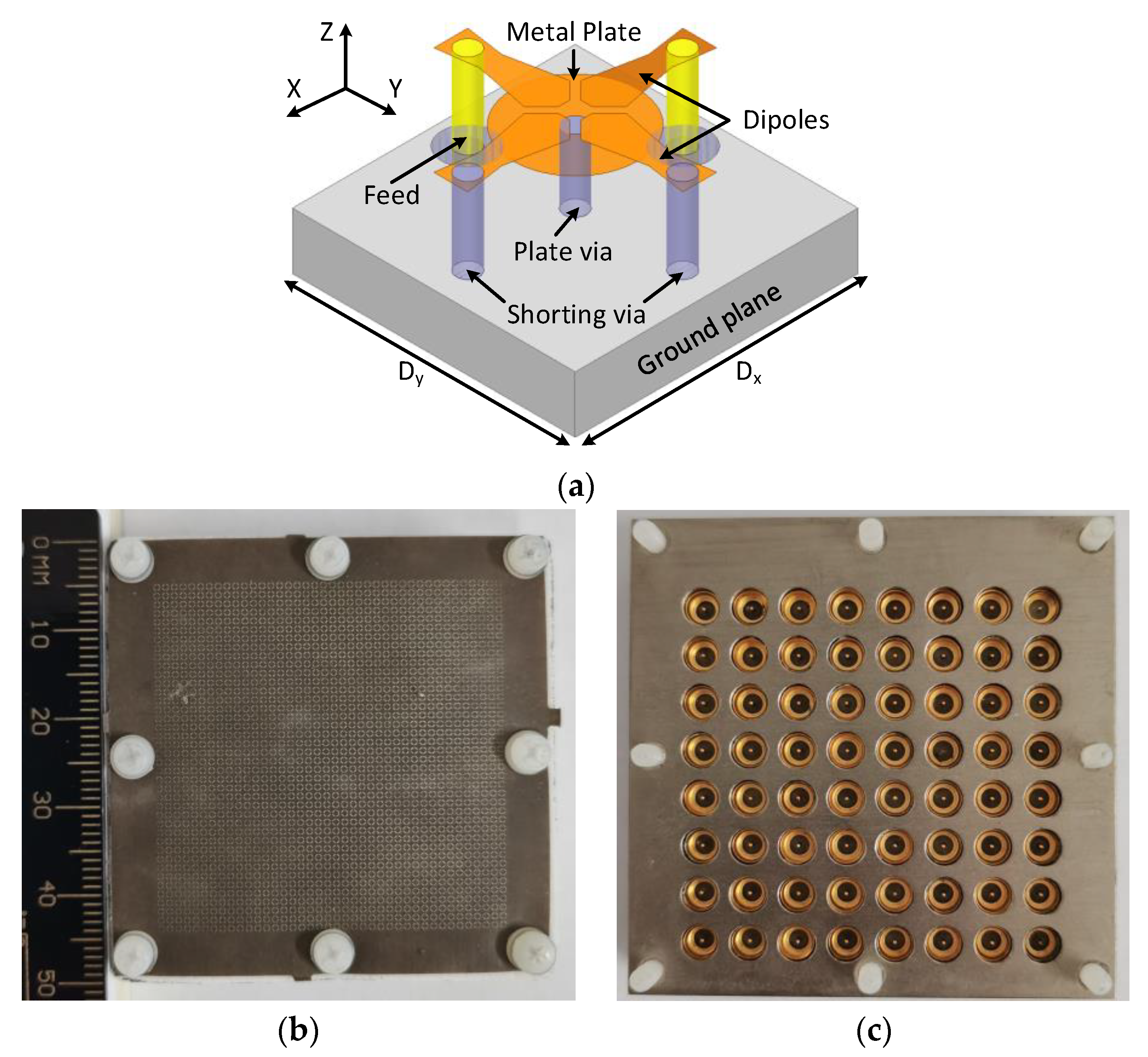

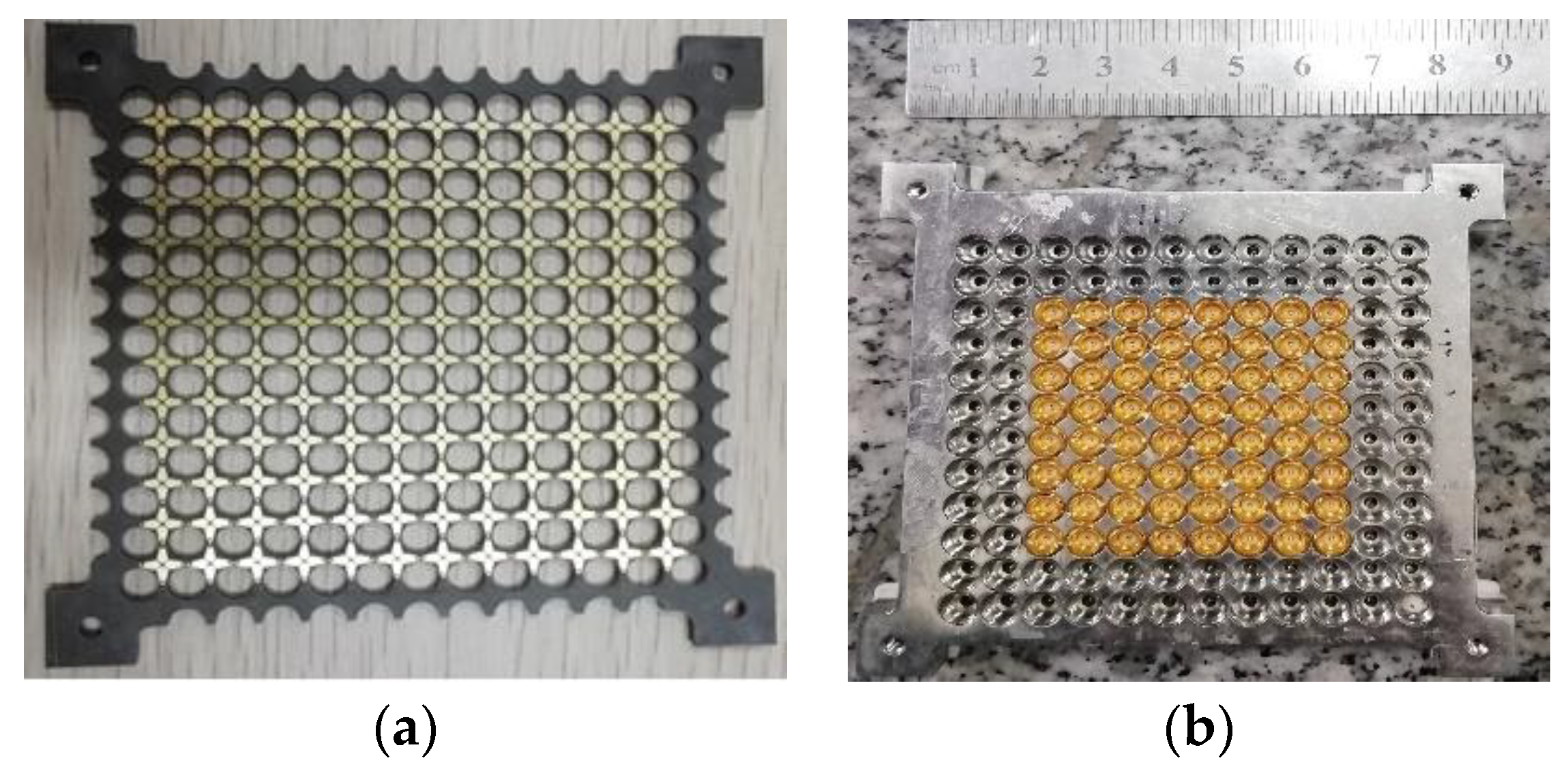


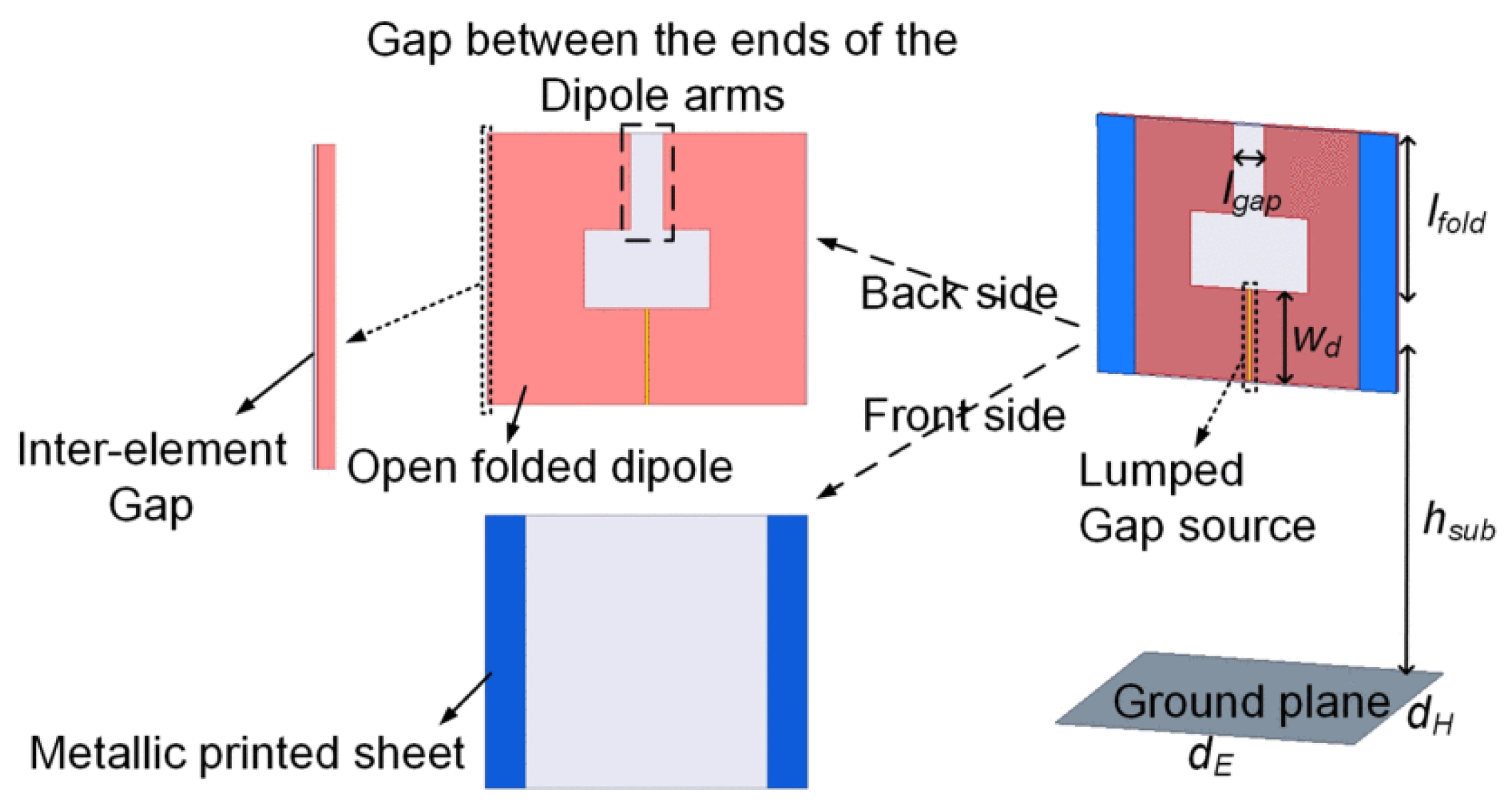

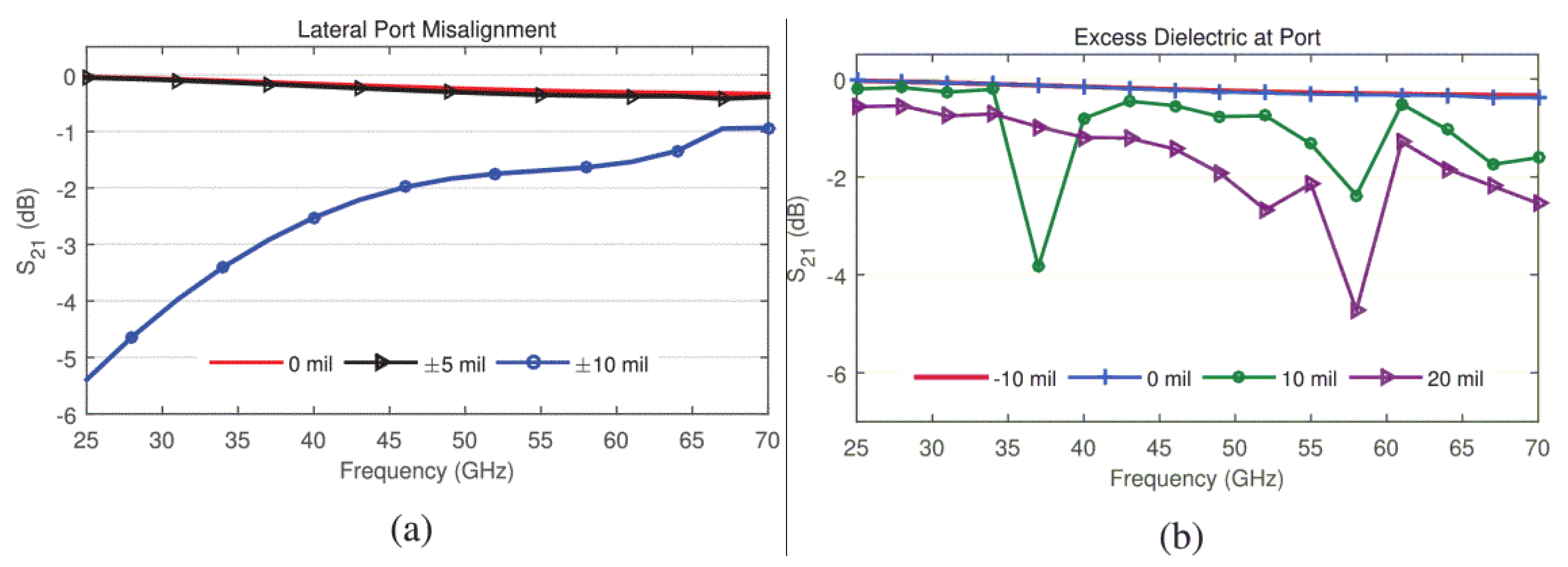
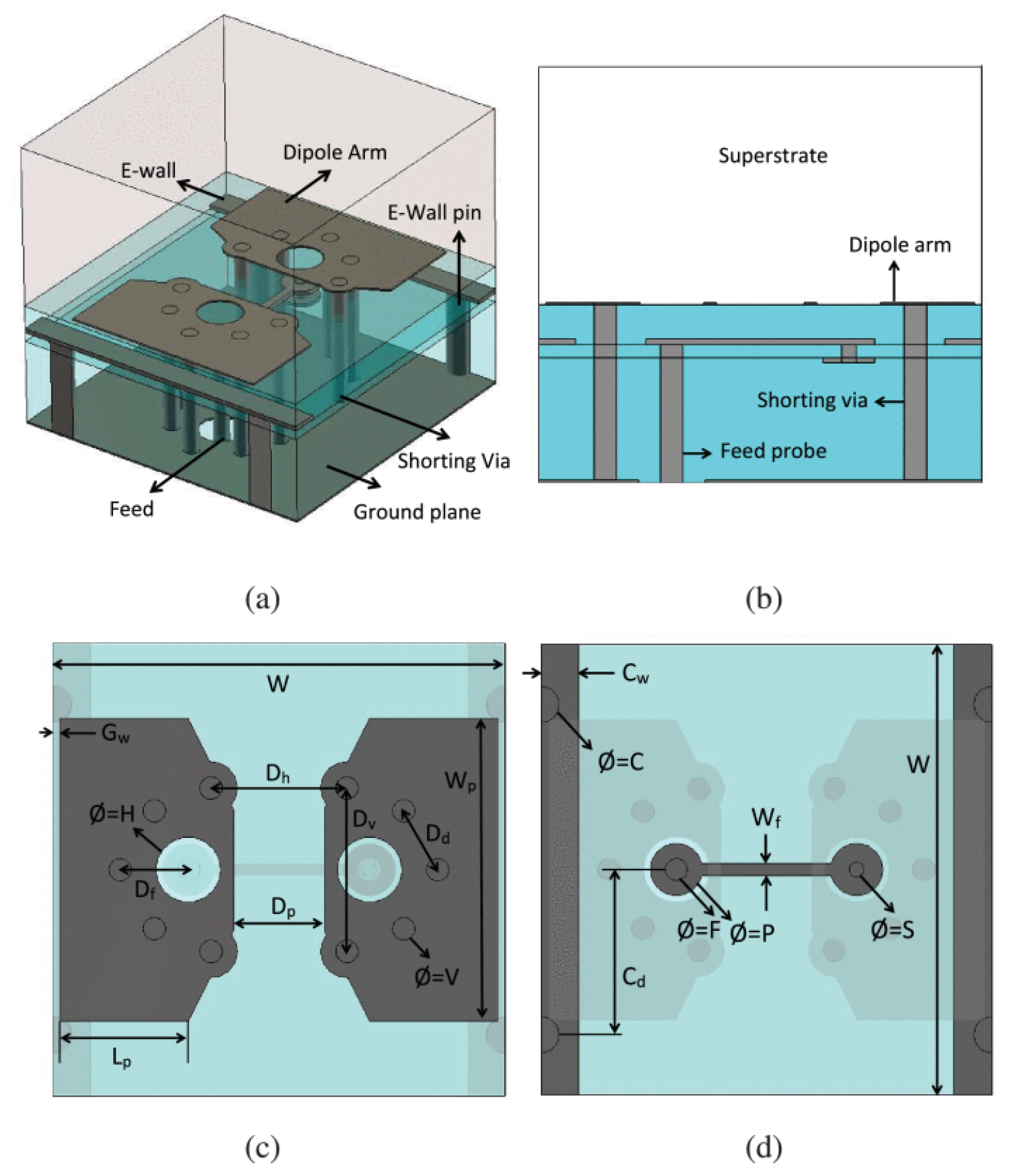
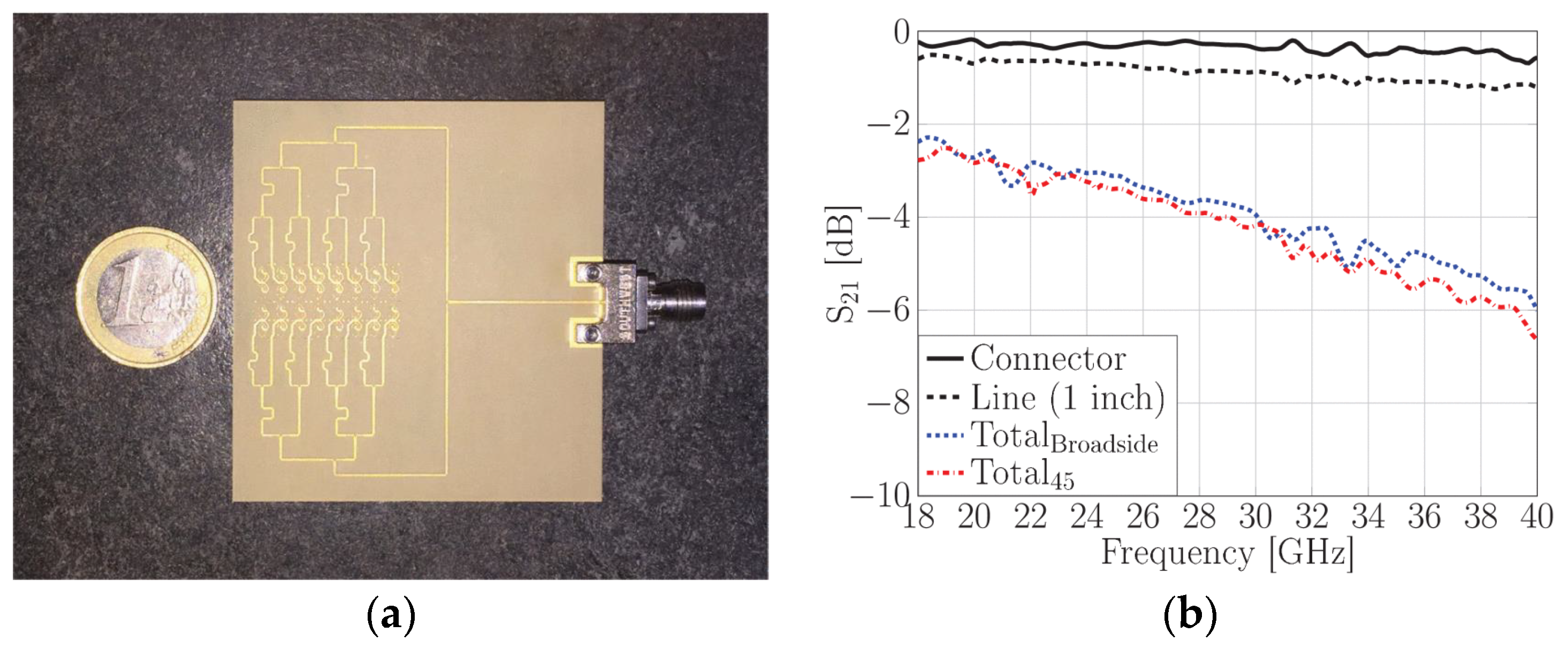


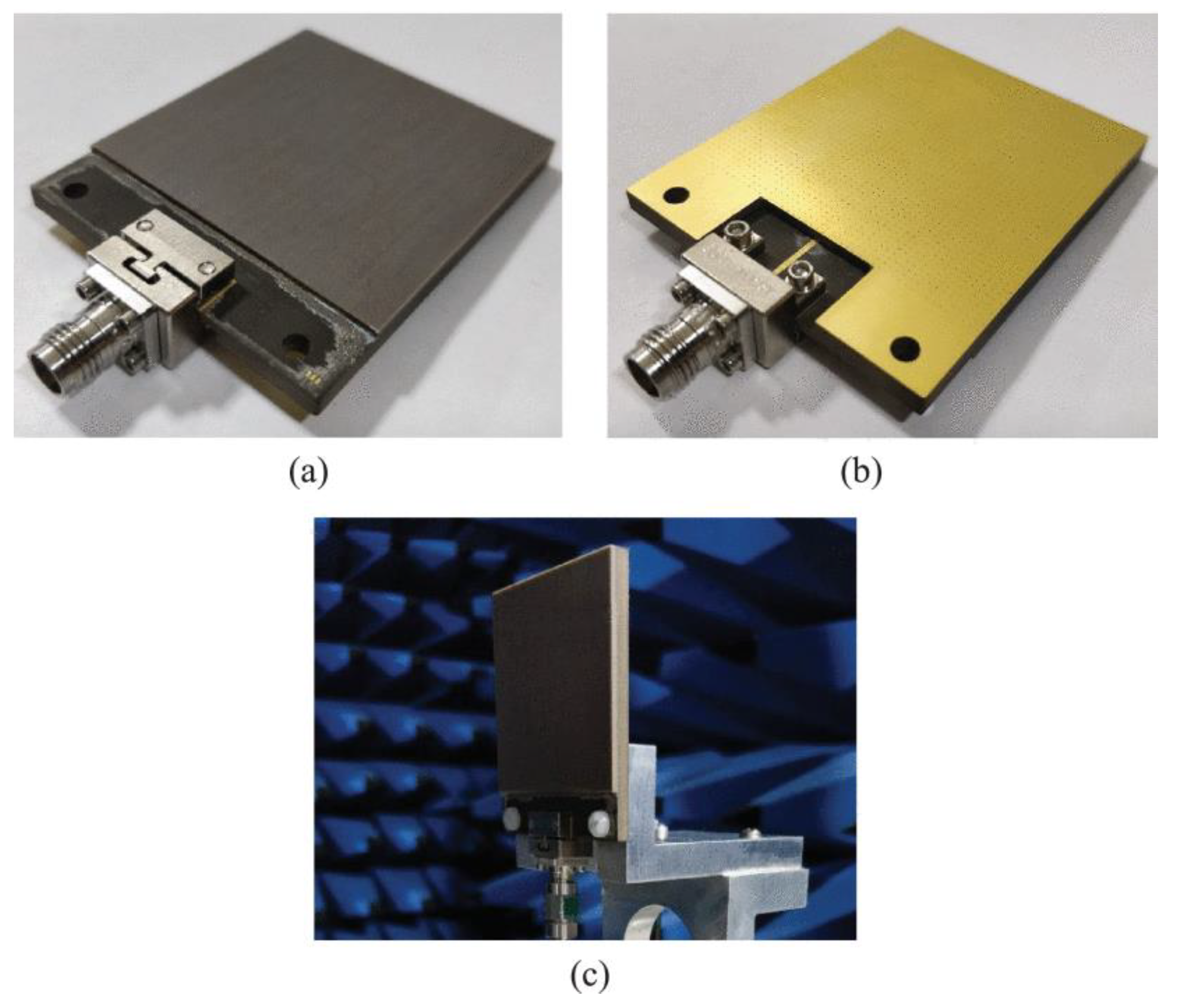



| Layers | Key Characteristics | Spectrum |
|---|---|---|
| Coverage and capacity | Primary band for 5G intro Decent coverage and capacity | Sub-6 GHz 3.3–4.2 GHz 4.4–5 GHz |
| Super data | Extremely high data rates Limited coverage | Millimeter-wave 24–29 GHz, 37–42 GHz 57–64 GHz, and above |
| Coverage | Wide-area coverage Deep indoor coverage | Below 2 GHz e.g., 700 MHz |
| Ref. | Bandwidth | Max Scan Angle (E-, H-, D-Plane) | Unit Element Dimensions (λh) | Maximum Realized Gain (dBi) | Insights/Salient Features |
|---|---|---|---|---|---|
| [38] | 7:1 (0.68–5.0 GHz) | 45°, 45°, 45° | 0.24 × 0.24× 0.68 | 19 |
|
| [41] | 5:1 (1.06–5.3 GHz) | 45°, 45°, 45° | 0.43 × 0.43 × 0.46 | NA |
|
| [47] | 21:1 (0.28–5.91 GHz) | NA * | 0.46 × 0.46 × 1.15 | 17.5 |
|
| [48] | 20:1 (0.85–17 GHz) | NA | NA × NA × 0.43 | NA |
|
| [52] | 4:1 (170–700 MHz) | NA, 30°, NA | 0.7 × 0.7 × 0.25 | 12.8 |
|
| [54] | 4.5:1 (5.6–25.5 GHz) | 40°, 40°, 40° | 0.59 × 0.59 × 0.71 | NA |
|
| [55] | 6:1 (0.6–3.6 GHz) | 60°,60°, NA | 0.41 × 0.41 × 1.04 | 23 |
|
| [56] | 13:1 (290–3900 MHz) | 45°, 45°, 45° | 0.44 × 0.44 × 1.59 | 20 |
|
| [57] | 6:1 (0.5–3.1 GHz) | 75°, 60°, 70° | 0.50 × 0.50 × 0.74 | 23 |
|
| Ref. | Bandwidth/5G Band | Max Scan Angle (E-, H-, D-Plane) | Unit Element Dimensions (λh) | Maximum Realized Gain (dBi) | Insights/Salient Features |
|---|---|---|---|---|---|
| [23] | 23.5–29.5 GHz/26, 28 GHz | 60°, 60°, 60°, Dual-polarized | 0.53 × 0.53 × 0.37 | 19.5 |
|
| [63] | 1.91–5.35 GHz/Sub-6 GHz | NA * | 0.37 × 0.44 × 0.22 | 11.2 |
|
| [64] | 2.2–6 GHz/Sub-6 GHz | 45°, -, - | 0.8 × 0.48 ** | > 6.9 |
|
| [68] | 0.3–2.2 GHz/Sub-6 GHz | 70°, 50°, 50° | 0.36 × 0.36 × 0.69 | 19 |
|
| [70] | 0.80–4.38/Sub-6 GHz | 70°, 55°, - | 0.35 × 0.35 × 0.48 | 22 |
|
| [72] | 0.3–2.15 GHz/Sub-6 GHz | 70°, 45°, -, Dual-polarized | 0.5 × 0.5 × 0.48 | 18 |
|
| [73] | 24–72 GHz/24, 26, 28, 38, 60, 66 GHz | 45°, 45°, 45° | 0.5× 0.5 × 0.39 | 14 |
|
| [74] | 22.5–32.5 GHz/24, 26, 28 GHz | 30°, -, - | 0.52 × 1.3 ** | 10.5 |
|
| [75] | 1.85–6.05 GHz/Sub-6 GHz | 80°, 40°, 70° | 0.41 × 0.41 × 0.12 | 23 |
|
| [76] | 17–42 GHz/24, 26, 28, 37 GHz | 45°, 45°, 45° | 0.42 × 0.42 × 0.43 | 20 |
|
| [77] | 0.20–5.6 GHz/Sub-6 GHz | 60°, 45°, 45° | 0.47 × 0.47 × 2.05 | 13 |
|
| [78] | 1.4–8.68 GHz/Sub-6 GHz | 60°, 60°, 60° | 0.47 × 0.47 × 0.8 | 19 |
|
| [79] | 18.1–30.4 GHz/26, 28 GHz | NA, circular polarization | 0.57 × 0.57 × 0.44 | > 21 |
|
| [80] | 1.05–3.20 GHz/Sub-6 GHz | 60°, 45°, 45° | 0.50 × 0.50 × 0.24 | NA |
|
Publisher’s Note: MDPI stays neutral with regard to jurisdictional claims in published maps and institutional affiliations. |
© 2022 by the authors. Licensee MDPI, Basel, Switzerland. This article is an open access article distributed under the terms and conditions of the Creative Commons Attribution (CC BY) license (https://creativecommons.org/licenses/by/4.0/).
Share and Cite
Hussain, S.; Qu, S.-W.; Sharif, A.B.; Abubakar, H.S.; Wang, X.-H.; Imran, M.A.; Abbasi, Q.H. Current Sheet Antenna Array and 5G: Challenges, Recent Trends, Developments, and Future Directions. Sensors 2022, 22, 3329. https://doi.org/10.3390/s22093329
Hussain S, Qu S-W, Sharif AB, Abubakar HS, Wang X-H, Imran MA, Abbasi QH. Current Sheet Antenna Array and 5G: Challenges, Recent Trends, Developments, and Future Directions. Sensors. 2022; 22(9):3329. https://doi.org/10.3390/s22093329
Chicago/Turabian StyleHussain, Sajjad, Shi-Wei Qu, Abu Bakar Sharif, Hassan Sani Abubakar, Xiao-Hua Wang, Muhammad Ali Imran, and Qammer H. Abbasi. 2022. "Current Sheet Antenna Array and 5G: Challenges, Recent Trends, Developments, and Future Directions" Sensors 22, no. 9: 3329. https://doi.org/10.3390/s22093329
APA StyleHussain, S., Qu, S.-W., Sharif, A. B., Abubakar, H. S., Wang, X.-H., Imran, M. A., & Abbasi, Q. H. (2022). Current Sheet Antenna Array and 5G: Challenges, Recent Trends, Developments, and Future Directions. Sensors, 22(9), 3329. https://doi.org/10.3390/s22093329








